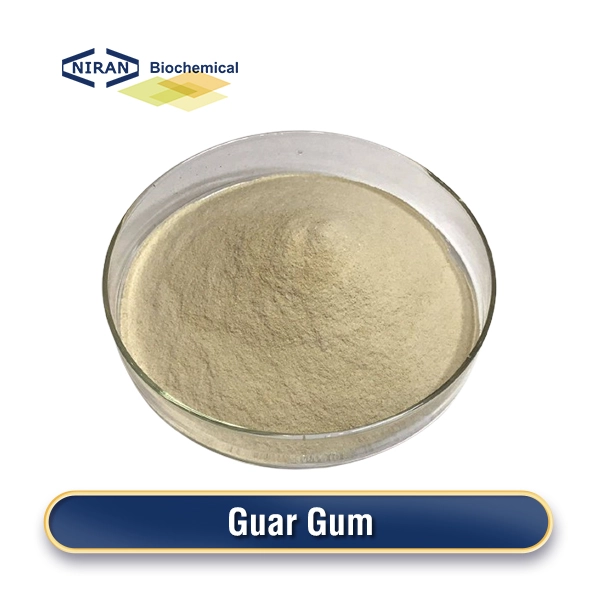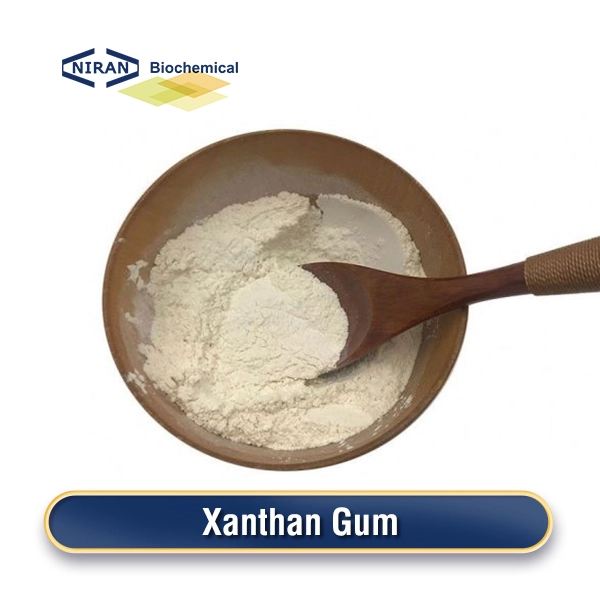Guar gum and xanthan gum are two popular thickeners and stabilizers that, despite their similar functions, differ in their sources, chemical composition, and specific applications.
This article provides a detailed comparison of the two gums, exploring their uses, advantages, limitations, and applicability across different industries.

1. What is Guar Gum?
Guar gum is a natural polysaccharide extracted from the seeds of the guar plant (Cyamopsis tetragonoloba), primarily grown in India and Pakistan. It is a galactomannan, a type of carbohydrate composed of mannose and galactose sugars, and is highly valued for its ability to thicken, stabilize, and emulsify products.
Characteristics:
- Water Solubility: Guar gum is highly soluble in cold water, and when hydrated, it can increase the viscosity of a liquid at low concentrations (as low as 1%).
- Viscosity Control: It creates a smooth, uniform texture and is commonly used in products like dairy items, soups, sauces, and baked goods. Its thickening properties are activated once it dissolves in water.
- Temperature Sensitivity: Guar gum performs well in cold and hot conditions but is more effective in cold applications due to its rapid hydration in cold water.

What is Xanthan Gum?
The bacteria Xanthomonas campestris ferments carbohydrates (such as glucose or sucrose) to generate xanthan gum, a polysaccharide. Unlike guar gum, which is plant-based, xanthan gum is a microbial product. It is extensively utilized in both culinary and non-food applications as an emulsifier, thickener, and stabilizer.
Characteristics:
- Water Solubility: Xanthan gum is soluble in both cold and hot water and can produce a consistent viscosity across a wide range of temperatures.
- Viscosity Control: It provides a stable viscosity even under varying conditions, such as changes in temperature, pH, or shear (e.g., stirring or shaking).
- Resilience to Stress: Xanthan gum maintains its structure and thickness even when exposed to high shear forces, making it ideal for products that are poured, pumped, or otherwise agitated.
Important Distinctions Between Xanthan and Guar Gum
While both guar gum and xanthan gum are used to thicken and stabilize, there are several critical differences between the two that influence their specific applications.
Origin and Manufacturing
- Guar Gum: Obtained naturally by means of extraction from guar plant seeds.
- Xanthan Gum: Produced by bacterial fermentation of sugars, followed by purification.
Solubility and Hydration
- Guar Gum: Best dissolved in cold water, with rapid hydration and the ability to thicken liquids quickly.
- Xanthan Gum: Soluble in both hot and cold water, and maintains a stable viscosity regardless of temperature or pH fluctuations.
Texture and Viscosity
- Guar Gum: Produces a thicker, more gel-like texture. It tends to be more suitable for applications that require significant thickening at low concentrations.
- Xanthan Gum: Produces a smoother texture and is more stable under stress, such as continuous stirring or mixing.
Viscosity Shear Sensitivity
- Guar Gum: Sensitive to shear, meaning that the viscosity of a guar gum-based product can decrease under continuous mixing or agitation.
- Xanthan Gum: Resistant to shear, allowing it to maintain its thickness even in stirred or agitated systems, such as salad dressings or sauces.
pH Stability
- Guar Gum: Less stable across a broad pH range; its effectiveness decreases in highly acidic or alkaline environments.
- Xanthan Gum: Highly stable across a wide pH range (from pH 2 to pH 12), making it suitable for acidic products like tomato sauces or alkaline environments like detergents.
Compatibility with Other Ingredients
- Guar Gum: Works well with starches but can have reduced functionality in high-acid or salt-heavy environments.
- Xanthan Gum: Extremely well-suited to a variety of substances, such as sugars, acids, and salts. It works synergistically with other gums (like guar gum) to enhance overall performance.
Applications of Guar Gum and Xanthan Gum
Food Industry
Both guar gum and xanthan gum are extensively used in food products, but their specific applications differ due to their unique properties.
Guar Gum in Food:
- Frequently added to dairy products including cheese, yogurt, and ice cream to enhance texture and stop ice crystals from forming.
- In baked goods, it enhances dough elasticity and moisture retention, improving the texture of gluten-free products.
- In soups and sauces, it acts as a thickener and stabilizer, providing a uniform, smooth texture without affecting flavor.
Xanthan Gum in Food:
- Widely used in salad dressings and sauces because of its ability to maintain viscosity even under shaking or mixing.
- In gluten-free baking, xanthan gum is often the preferred binder as it gives a smoother, more consistent texture to baked goods.
- Used in beverages to stabilize particles and prevent them from settling, ensuring a uniform suspension in drinks.
Pharmacological sector
- Guar Gum in Pharmaceuticals: Tablet formulations contain guar gum as a disintegrant and binder. Its high fiber content also makes it valuable in laxative products.
- Xanthan Gum in Pharmaceuticals: Topical gels and oral solutions frequently contain xanthan gum. It acts as a stabilizer in creams, ointments, and other pharmaceutical formulations, ensuring a consistent texture and effectiveness.
Personal Care and Cosmetics
- Guar Gum in Personal Care Products: Guar gum is used in shampoos, conditioners, and lotions to thicken and stabilize formulations. It adds smoothness and helps hydrate skin and hair.
- Xanthan Gum in Cosmetics: Xanthan gum provides thickening and emulsification in skincare and cosmetic products. Its ability to maintain stability over time, despite varying temperatures, makes it ideal for lotions, creams, and gels.
Industrial Applications
- Guar Gum in Industrial Uses: In order to make drilling fluids more viscous, guar gum is widely employed as a fracking agent in the oil and gas sector. In the paper and textile sectors, it is also utilized as a thickening agent and sizing agent.
- Xanthan Gum in Industrial Uses: Xanthan gum is used in enhanced oil recovery as a rheology modifier and in adhesives, paints, and coatings to improve flow properties.
Health Considerations and Dietary Uses
Both guar gum and xanthan gum are safe for human consumption, though there are some differences in their health benefits and potential side effects.
Guar Gum: Health Benefits and Side Effects
- Benefits to Health: The high soluble fiber content of guar gum is good for the health of the digestive system. It can lower cholesterol and assist regulate blood sugar levels. Because it encourages a sensation of fullness, it is often utilized as a weight loss aid.
- Side Effects: Large-scale guar gum use might result in stomach problems such gas, bloating, and cramps. However, when used in standard food-grade dosages, it is generally considered safe.
Xanthan Gum: Health Benefits and Side Effects
- Health Benefits: Xanthan gum may have some benefits for people with diabetes, as it helps to slow digestion and can improve blood sugar control. It is also often used in weight management programs because of its ability to make products more filling.
- Side Effects: Excessive intake of xanthan gum may result in gastrointestinal problems including gas and bloating. In excess, it can also function as a laxative. However, the typical amounts found in foods are safe for most people.
Guar Gum vs. Xanthan Gum in Gluten-Free Products
Guar gum and xanthan gum are frequently employed as gluten alternatives in gluten-free baking, giving baked goods their structure and suppleness. However, they differ in their performance:
- Guar Gum in Gluten-Free Baking: Provides excellent thickening and moisture retention, but can lead to a more crumbly texture in baked goods.
- Xanthan Gum in Gluten-Free Baking: Offers superior binding and creates a smoother, more elastic dough, resulting in a better texture that more closely mimics gluten-containing products.
Data information comparison
| Feature | Guar Gum Data | Xanthan Gum Data |
| Viscosity Range | 1,000 – 3,000 cps (centipoise) at 1% concentration in water | 1,200 – 1,500 cps at 1% concentration in water |
| Concentration Required for Thickening | 0.5% – 1% in food applications | 0.1% – 0.5% in food applications |
| Optimal pH Range | Effective in pH range of 4 – 10 | Effective in pH range of 2 – 12 |
| Typical Dosage in Food | 0.2% – 1% for most products | 0.1% – 0.3% for most products |
| Hydration Time | Hydrates in cold water in 15 – 20 minutes | Hydrates in cold or hot water for about 10 minutes |
| Temperature Stability | Stable up to 80°C (176°F) | Stable up to 100°C (212°F) |
| Cost per kg (approx.) | $3 – $6 per kg (varies by region) | $8 – $12 per kg (varies by region) |
| Shelf Life | 1 – 2 years under proper storage conditions | 2 – 3 years under proper storage conditions |
| Synergistic Behavior | Works well with locust bean gum, starch, agar | Works well with guar gum, carrageenan, and locust bean gum |
| Solubility Time (Cold Water) | About 30 minutes for complete dissolution | Dissolves completely in 10 – 15 minutes |
Cost and Availability
- Guar Gum: Generally, guar gum is more affordable than xanthan gum, particularly in regions where guar plants are grown. However, prices can fluctuate based on crop yields.
- Xanthan Gum: Xanthan gum tends to be more expensive because its production involves fermentation and specialized equipment.
Conclusion
Xanthan gum and guar gum have unique qualities suitable for different applications, and choosing between them depends on factors such as cost, solubility, shear resistance and stability.
